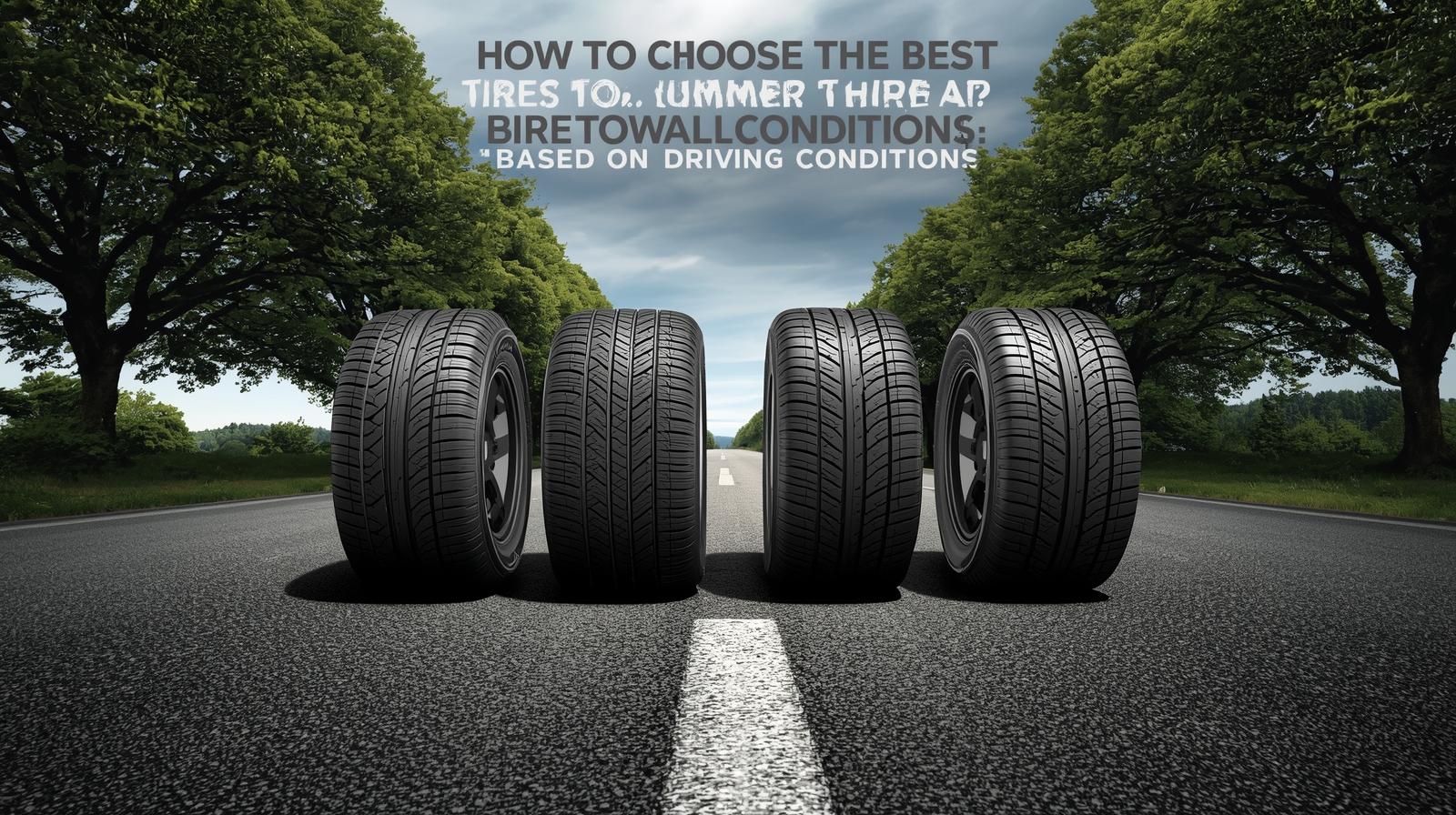Choosing the best tires for your car is one of the most important decisions you can make for ensuring your vehicle’s performance, safety, and longevity. Tires are the only point of contact between your car and the road, and they play a crucial role in everything from handling and comfort to braking distance and fuel efficiency. In this guide, we’ll help you understand how to choose the best tires for your car based on driving conditions, making sure you make an informed choice for the safety and performance of your vehicle.
1. Why the Right Tires Matter?
Before we dive into how to choose the best tires for your car, it’s important to understand why selecting the right tires matters so much. Tires impact:
- Safety: Tires with poor tread or incorrect specifications can significantly reduce your car’s ability to grip the road, especially in adverse conditions like rain or snow.
- Performance: Tires affect your car’s handling and stability. Whether you’re driving in urban areas or taking on rough terrain, the right tire will improve overall performance.
- Fuel Efficiency: Some tires are designed to reduce rolling resistance, which can help you save on fuel costs.
- Comfort: A tire that’s suited for the right road conditions can improve ride comfort by absorbing bumps and vibrations.
When choosing the best tires for your car, it’s essential to factor in your usual driving conditions, from weather to terrain and driving habits. Let’s explore each aspect to help you make the best decision.
2. Identifying Your Driving Conditions
Before selecting the best tires, you need to evaluate your typical driving conditions. Your location, lifestyle, and daily commute all influence the type of tires you should choose. Here’s a breakdown of common driving conditions that will determine which tires are best for your car:
a) Weather Conditions:
- Dry Conditions: If you live in an area that experiences mostly dry, warm weather, all-season tires or summer tires may be your best bet. All-season tires are versatile and work well in both dry and wet conditions, while summer tires are specifically designed for dry roads and offer superior grip and handling.
- Rainy Conditions: If you experience frequent rain, look for tires with deeper tread patterns and those designed for wet conditions. Tires designed for wet conditions typically feature specialized grooves that channel water away from the tread, reducing the risk of hydroplaning.
- Snowy or Icy Conditions: For snowy, icy, or freezing conditions, winter tires are essential. These tires are made from special rubber compounds that remain flexible in low temperatures, ensuring superior traction on ice and snow. They also have deeper treads and specific patterns to improve grip on slippery surfaces.
b) Terrain Type:
- Highway or City Driving: For those who mainly drive on paved roads, performance-oriented tires are ideal. These tires provide excellent handling and stability at high speeds, improving both comfort and control.
- Off-Road or Rugged Terrain: If you drive on rough or unpaved roads frequently, consider off-road tires or all-terrain tires. These tires have more aggressive tread patterns and thicker rubber to withstand rugged conditions, providing better grip on dirt, mud, or gravel roads.
c) Driving Habits:
Your driving style can also influence the type of tire that’s best for your car. For example:
- Aggressive Drivers: If you tend to drive fast or take corners sharply, performance tires designed for handling and stability are essential.
- Eco-conscious Drivers: If fuel efficiency is a priority, look for low rolling resistance tires. These tires reduce the energy required to move your car, improving gas mileage.
3. Types of Tires to Consider
There are several types of tires available in the market, each designed for different driving conditions. Let’s explore the most common types:
a) All-Season Tires:
All-season tires are a popular choice for many car owners because they provide a balance of performance in both dry and wet conditions. These tires are suitable for most driving conditions but are not designed for extreme winter or off-road situations. If your location experiences mild winters and you don’t often drive in snow or ice, all-season tires may be the best choice for your car.
b) Summer Tires:
If you live in a warm climate with dry conditions, summer tires might be the best option for your car. These tires are designed to provide maximum performance on dry roads, offering superior handling, braking, and cornering capabilities. However, they aren’t suitable for cold or snowy conditions.
c) Winter Tires:
Winter tires are specifically designed to handle cold weather, snow, and ice. If you live in a region that experiences harsh winter conditions, investing in a set of winter tires can greatly improve your vehicle’s performance and safety. These tires feature deeper tread patterns and special rubber compounds that remain flexible in cold temperatures, providing better traction on slippery surfaces.
d) Off-Road Tires:
If you frequently drive on rugged terrain or go off-roading, off-road tires are a must-have. These tires are built to handle dirt, gravel, rocks, and other rough surfaces. They are typically larger, with deeper treads, to offer better traction on uneven surfaces.
e) Performance Tires:
Performance tires are designed for drivers who want enhanced handling, speed, and overall driving performance. These tires offer superior grip on dry pavement and are a great choice for sports car owners or anyone who enjoys driving on winding roads or highways.
f) All-Terrain Tires:
All-terrain tires are a hybrid between off-road and on-road tires, offering a balance of performance on both paved and unpaved surfaces. These tires are perfect for drivers who occasionally venture off-road but still need to drive on highways regularly.
4. Tire Size and Specifications
Once you’ve determined the type of tire that best suits your driving conditions, the next step is to select the correct tire size. The size of the tire is important because it affects the handling, fuel efficiency, and overall performance of your vehicle.
To find the correct tire size, refer to your vehicle’s owner’s manual or check the tire placard located on the driver’s side door frame. The tire size will be displayed as a series of numbers, such as P215/60R16. Here’s what these numbers mean:
- P: Type of tire (P stands for passenger vehicle).
- 215: Width of the tire in millimeters.
- 60: Aspect ratio (the height of the tire sidewall as a percentage of the tire’s width).
- R: Radial construction of the tire.
- 16: Diameter of the wheel in inches.
Choosing the right tire size ensures compatibility with your vehicle and enhances performance.
5. Tire Brands and Quality
Not all tires are created equal, and tire brands can vary greatly in quality. When selecting the best tires for your car, it’s important to research reputable tire brands. Some top brands include Michelin, Goodyear, Bridgestone, and Continental, all of which are known for producing high-quality, durable tires that provide great performance and safety.
Conclusion
Choosing the best tires for your car based on driving conditions is a critical decision for your vehicle’s safety and performance. By considering factors like weather conditions, terrain type, driving habits, and tire specifications, you can ensure that you select the right tires for your needs.
Whether you need all-season tires for mild weather, winter tires for snowy conditions, or off-road tires for rugged terrain, the right choice will keep you safe on the road and enhance your driving experience.
FAQ’s
How often should I replace my tires?
Tires should be replaced every 6 years, but they can last up to 10 years depending on usage and maintenance. You should also replace tires if the tread depth reaches 2/32 inches or if they show signs of wear or damage.
Can I mix different types of tires on my car?
It is generally not recommended to mix different types of tires (e.g., winter and summer) on the same vehicle, as this can affect the handling and safety of the car. Always replace tires in pairs or sets of four.
Do I need different tires for front and rear axles?
In most cases, tires should be the same size and type on all four wheels. However, if your car has a performance or rear-wheel drive configuration, it may require different tires on the front and rear axles.
How do I know if my tires are the right size?
Check the tire placard on the driver’s side door frame or refer to your car’s owner’s manual for the recommended tire size. The tire size is printed on the sidewall of the tire itself.
Are all-season tires good for winter driving?
While all-season tires are designed for year-round use, they are not ideal for winter conditions. If you live in a region with harsh winters, consider investing in winter tires for better traction and safety on snow and ice.





